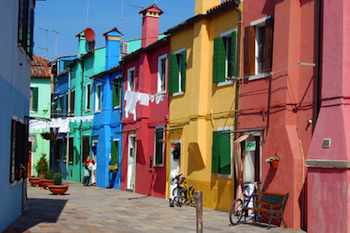- MENU
- HOME
- SEARCH
- WORLD
- MAIN
- AFRICA
- ASIA
- BALKANS
- EUROPE
- LATIN AMERICA
- MIDDLE EAST
- United Kingdom
- United States
- Argentina
- Australia
- Austria
- Benelux
- Brazil
- Canada
- China
- France
- Germany
- Greece
- Hungary
- India
- Indonesia
- Ireland
- Israel
- Italy
- Japan
- Korea
- Mexico
- New Zealand
- Pakistan
- Philippines
- Poland
- Russia
- South Africa
- Spain
- Taiwan
- Turkey
- USA
- BUSINESS
- WEALTH
- STOCKS
- TECH
- HEALTH
- LIFESTYLE
- ENTERTAINMENT
- SPORTS
- RSS
- iHaveNet.com: Travel
By Rick Steves

Pastel Houses line the streets of Burano
Pastel houses line the streets of Burano, an island in Venice's lagoon.
When you know where to look, there's so much to see in Venice. Stepping ashore after a boat ride from the airport, I noticed everything seemed particularly vivid in this beautifully decrepit cityscape: Pilings rotten at the water line ... a funeral boat with an iron casket-rack lashed to the center of the hull ... chandeliers lighting a mansion's ceiling frescoes, which couldn't be seen during sunlit hours ... white marble inlay that made the edge of some stairs pop.
I spent my first two days avoiding St. Mark's Square. It's the back lanes where this enchanting city is most intriguing. An inverted corner of a beautiful church had an ugly iron fence cutting across it. Why? So men won't use it as an outdoor urinal. In Gothic times, the architect couldn't have imagined someone would relieve himself against the corner of a church. But this is a different age. Later I was walking on an unusually wide street. "What's this doing in Venice?" I thought. "Oh ... it's a filled-in canal."
Then there are times when the magic suddenly stops. I needed to check out the parking situation at the edge of the city, and the traffic appalled me. As I dodged the crazy Italian drivers, the contrast was clear: What a charming world the Venetians enjoy -- no traffic noise and as pedestrians they completely own their byways.
Back on the water, I tried out one of my Venice audio tours, which are MP3 files anyone can download for free from www.ricksteves.com. I got out my iPhone and let Rick Steves guide me down the Grand Canal. It reminded me of how I used to commandeer the front seats of the same slow boat when I was a young tour guide back in the 1970s, barking out a cruder version of that same narration to my groups.
Another boat ride took me to the nearby island of Burano, which is famous for humble fishermen's houses and squinting lace-makers. I noticed how the pastel colors of the homes are getting more and more vibrant. The place is just darling (an adjective I've never used to describe a town before).
But the rising sea has forced Burano to raise its canal-side pavement. I could see a strip of fresh bricks above the water line. Some houses had a new step added from the sidewalk down to their doors, while others just had a shorter door.
Back in the city, St. Mark's Square is about to have its pavement raised for the third time in history. Venice has been battling rising water levels since the fifth century. But today, the water is winning. Locals tell me that due to many factors, including global warming, Venice now floods about 100 times a year -- usually from October until late winter -- a phenomenon called the "acqua alta." During these floods, some high-end hotels lend boots to their customers. Wooden benches are placed end-to-end in St. Mark's Square to create elevated sidewalks. It turns into total gridlock, as all the people normally sharing the whole square jostle for space on these narrow wooden walkways.
The flooding is getting worse because Venice is sinking, and the sea is rising. The city sits atop sediments deposited at the ancient mouth of the Po River, which are still compacting and settling. Twentieth-century industry worsened things by pumping out massive amounts of groundwater from the aquifer beneath the lagoon. Add to that the effects of climate change -- rising sea level from melting polar ice caps, thermal expansion of the water itself as temperatures rise, and storms that are more frequent and more powerful -- and it makes a high sea that much higher.
After decades of debate, Venice is finally doing something about the flooding. Underwater "mobile" gates are being built at the entrances of the three inlets that lead into Venice's lagoon. When the seawater rises above a certain level, air will be pumped into the gates, causing them to rise and shut out the Adriatic. It could be operational by 2014, but will it work? Time ... and tides ... will tell.
Done with my boat ride, I retreated to my hotel room. The speckled "Venetian pavement" -- the city's characteristic floor made of a broken hodgepodge of marble fragments and then polished -- greeted my bare feet. While some might mistake it for cheap linoleum, it's far from that -- it's treasured here, and quite expensive. It flexes with the settling of the buildings ... so costly to maintain, but so characteristic. This was a sign that I was back in one of my favorite cities. My feet connected with the floor in a way my feet have never before connected with flooring ... happily grounding me in Venice.
© Rick Steves' Europe
AUTOS | HOBBIES | EDUCATION | FAMILY | FASHION | FOOD & RECIPES | HOME DECOR | RELATIONSHIPS | PARENTING | PETS | TRAVEL | WOMEN
Travel | Barefoot in Venice Italy